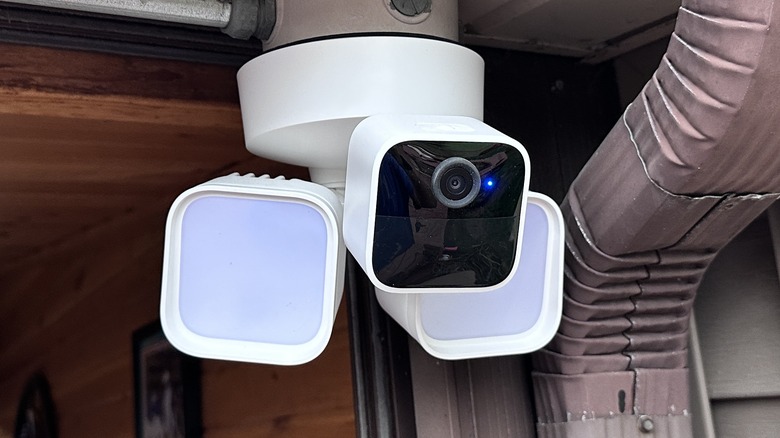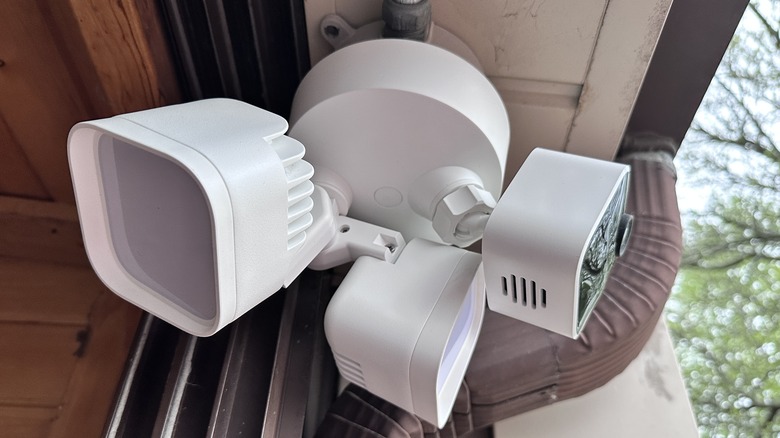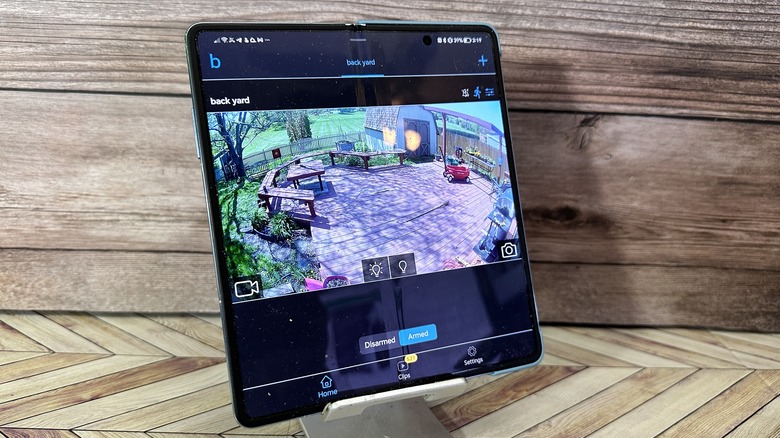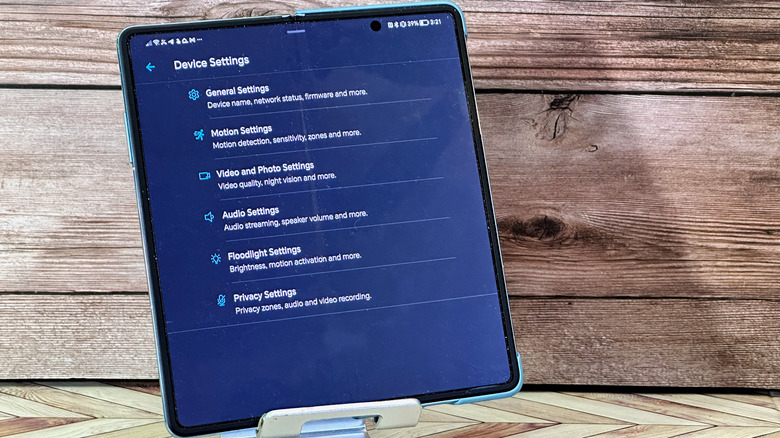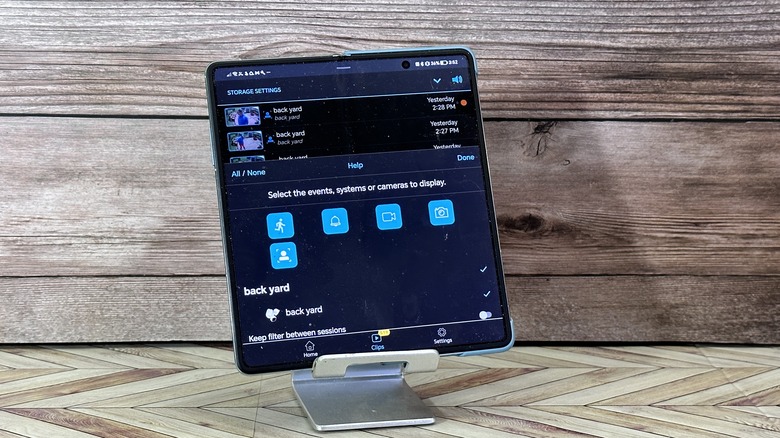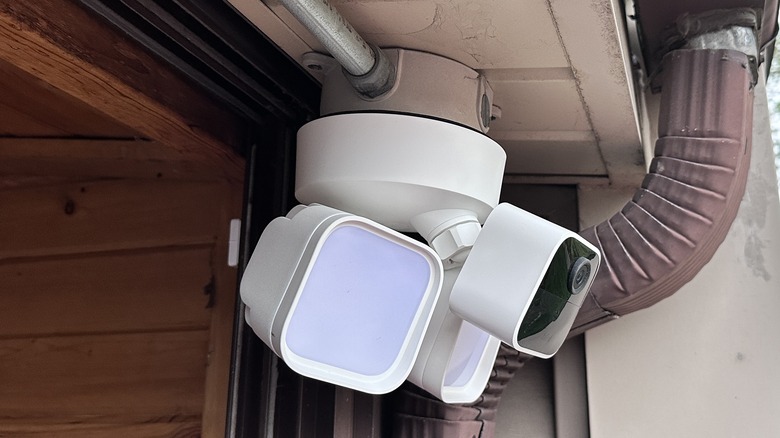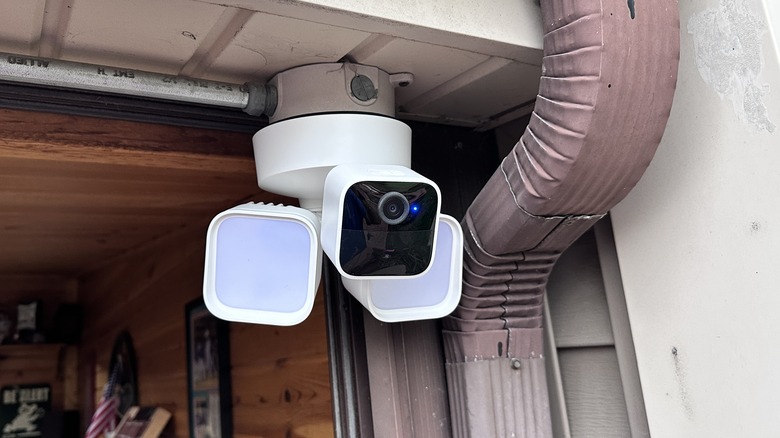Blink Wired Floodlight Camera Review: A Nice Entry Point To A Smart Home
- Wired ensures constant power
- Nice camera quality
- Great motion detection
- Highly customizable experience
- Hard to install
- The software isn't great
One of the easiest ways you can get into smart home technology is to add a camera to your home. For some, this comes in the form of a doorbell like the Vivint Doorbell Camera Pro Gen 2; others will add a security camera on a wall somewhere. Regardless of which way you go with it, you now have eyes on the outside of your house whenever you need them. Plus, it's a smart home addition that doesn't necessarily put too much of a burden on your wallet.
The Blink Wired Floodlight Camera is designed to do just that, but it comes with the cost of a few compromises. Outdoor cameras are in a crowded space and different companies will cut different corners in an effort to keep costs down. To that end, Blink made some good calls and left out a couple of things that are usually nice to have in an outdoor camera. I have been using a Blink Wired Floodlight camera review sample provided by Blink for three weeks and this is my full review.
Hardware and installation
As the name suggests, there are two main components to this outdoor camera: there's the floodlight which comes in the form of two floodlights that you can aim, and the camera itself. All three are mounted to a round base which is designed to attach directly to an electrical box mounted on your wall or ceiling; it comes with the hardware to do so.
In my case, the hardware designed to hold the camera in place broke when I tried to force the nut onto the bolt too hard — that was my fault, so I had to take a quick trip to the hardware store to fix it. Once I did, the installation went smoothly. The camera is designed to be wall mounted, though I mounted mine to the ceiling below the overhang on my back deck. The base of the camera has a foam gasket to keep rainwater out.
Of course, also as the name implies, this camera needs to be wired to your home's electrical wiring — there's no battery here. You'll likely be replacing an existing outside fixture. Speaking of which, the camera only comes in white, so you'll want to make sure whatever you're replacing goes along with the decor. Once installed, you can aim the floodlights and camera in just about any direction you want. The camera has a ball joint you can aim, while the floodlights have extendable arms to get a little more reach out of them.
The camera
Once installed, you get a 1080p camera with a 143-degree diagonal field of view. That's wide enough to cover about half of my backyard and more than enough to see most of my back deck. The colors on the camera are sharp, and there's very little fish-eye effect from the wide-angle lens. Clarity on the picture is good as far back as 20 feet, after which subjects start to get quite pixelated. Security cameras are adept at collecting footage that happens right in front of them and less so capturing subjects far away. That's why camera placement is critical when deciding to add one to your home.
Motion detection is also very solid and accurate. I placed this camera right above the doorway where my three dogs exit and enter the house and I never had any trouble missing them going either way. Further, small animals like rabbits routinely tripped a motion activity, and as a result, I usually woke up with a few new clips in the library. All of this comes together into a nice hardware package.
One area where Blink does a really good job is avoiding false positives with the motion activation. Many cameras will accidentally see the shadow of a tree blowing in the wind and capture footage saying it detected motion. This camera doesn't do that. The only clips it recorded were of actual people or animals outside the house, even though the shadow of my tree falls across the deck and has a tendency to trigger motion alerts from other cameras. Blink gets kudos in this department.
Software struggles
The software that runs the camera is laid out in an odd way. When you open the app, you're treated to a static view of the camera which takes up most of the screen. From here you can take a photo of what's happening in front of the camera or you can jump into watching the video feed. There is no way to scrub backward or forward in the feed — you're only able to see what's going on now and what has triggered an event (and recorded an accompanying clip).
Personally, I like the ability to scrub through footage to see what's happening on a timeline, rather than a collection of individually recorded clips. You may not be bothered by that. After all, if nothing happened, why should I care? That's a solid argument but I at least would like to have the option of scrubbing back and forth if I want to.
Another confusing part of the software is the presence of two sets of settings. There are Blink settings and Device settings, but Blink settings have a Device and system settings option as well. It took me a week to figure out where things like motion detection settings were because I hadn't found the second set of settings yet. Those need to be a little more conspicuous.
There is also no way to flip the camera image. When I initially installed the camera, the picture was upside down. The way the camera and lights were positioned in the corner seemed to be the best way to make everything fit. However, since there was no way to flip the image, I had to turn the camera on its ball joint. Everything still fits, but it would have been much easier to flip it with software.
Software isn't all bad
Once you find those Device settings, you get a lot more options. You can actually adjust quite a bit through the app from floodlight intensity, clip length when motion is detected, IR intensity for night vision, and more. You can adjust motion detection zones, adjust what motions will trigger a recording event, and so on. Basically, once you find the secondary settings, you can tweak the camera and floodlights until your heart's content.
The clips are laid out sequentially as they occurred and they can be filtered to show only people, all movement, etc., but the filters are shown as icons only with no text labels so it can be a little hard to decipher. For example, what's the difference between a person walking and a profile shot of a person in a square?
Overall, I'd say the software here needs a lot of work, which is odd because Blink is not new at this. Considering both Blink and Ring are owned by Amazon, I'd like to see a little Ring inspiration injected into the software here as well.
Other test notes
The Blink Wired Floodlight Camera also has a siren built in that is rather annoying and loud. You can manually trigger it, but there's no automatic way to do so. There's also two-way audio which is a nice add-on. Speakers are loud and clear when broadcasting through the camera.
I mentioned that I broke the bracket when trying to attach the camera to the electrical box. That was mostly my fault, and easily fixed, but it should be mentioned that the crossbar you're mounting the camera on is not standard and not easily replaceable — at least not at Home Depot. I ended up buying a new bolt and two nuts to replace the broken bolt. Easy enough to fix, but for the record, maybe don't use an electric drill when installing the light. Lesson learned.
You are going to want to get a Blink subscription which enables up to 90 minutes of continuous live vids, and a lot of other extras like cloud saving of footage and video sharing. The subscription is $3 per month for a single camera or $10 per month for unlimited devices. Unfortunately, the future of smart home cameras comes with a subscription cost.
Blink Wired Floodlight Camera final verdict
Overall, this is a pretty decent deal for a smart home camera, but you have to know what you're getting. Battery-operated cameras are a lot easier to set up, but they come with their own compromises. Setting up a wired camera is not the easiest thing to do, but it's also not terribly hard. The hardest part is finding a place where you have an existing electrical box to mount one or a place where you can mount a new box and run power to it. The nice thing about this camera is the flood light can also serve as a light, so you can replace an exterior light as I did.
The software isn't the best. Depending on your opinion of being able to scrub through footage, maybe the software isn't a deal-breaker for you. I'd like to see a little more attention paid to laying out the software in a more intuitive way. Ring has a really great software experience that Blink can borrow very easily.
But overall, for $99 (available at Amazon, of course) this isn't a bad way to enter the space. You won't have to worry about setting up a solar panel or charging a battery, and it's not prohibitively expensive like other cameras that are out there. Blink has a solid reputation in the home security space, so you won't have to worry about what's happening to your private data. So if you're looking to take the leap, this is not a bad place to start, as long as you have a place (and the know-how) to install it.
